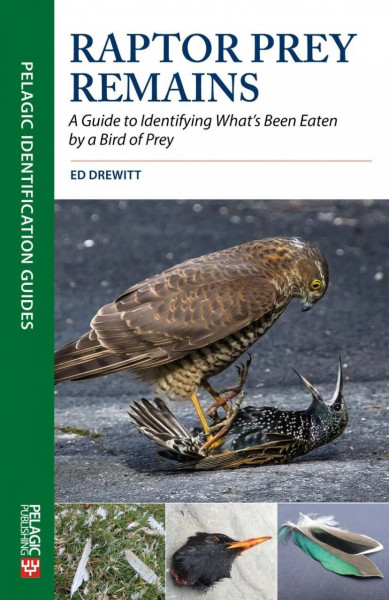
Publisher: Pelagic Publishing, Exeter
Publication Year: 2020
Binding: 1
Page Count: 256
ISBN Number: 9781784272074
Price: £24.99
Raptor Prey Remains: A Guide to Identifying What’s Been Eaten by a Bird of Prey
Upon receiving this book, I showed it to my non-birding partner, who saw the front cover and described it as “traumatic”. This is not a book for the squeamish, as the graphic front cover featuring the final moments of a Starling’s life makes abundantly clear. Rather, this is a book that may appeal to raptor workers or other ecologists as a reference tool in the exciting whodunnit mysteries that prey remains present to those of us with a fascination for such things.
Much of this book is made up of close-up images of prey remains, with other images showing raptor hunting and feeding behaviour. Most of the images are clear and show prey remains in situ, though sadly a few of these images are quite poor quality. The book starts with the basics of how to recognise the signs of a bird kill versus a mammal kill, with some brief summaries of the usual situations in which different raptor and owl species leave the remains of their prey. The book then helpfully signposts resources for further research into the identification of prey remains and gives a basic introduction to bird feathers and anatomy. The main part of the book is devoted to the most frequently encountered prey remains by species in taxonomic order, starting with mangled Mallard, right through to ripped-up Reed Buntings. Mammal prey are briefly covered, and I must say I especially enjoyed the images of Goshawk nests laden with the corpses of Grey Squirrels.
I took the opportunity to test this guide in the field with my long-suffering partner, by visiting our local Peregrines which frequent the grand steeple of Galashiels’ Old Parish Church, the surrounding grounds of which are littered with bones, feathers and pellets. We very quickly found our first identifiable skull by using the book; that of a long-departed Woodcock (which now has pride of place on our shelves). We had difficulty with some of the more decomposed parts, and though the main focus of the book is about identification using feathers, feet and skulls, a brief description or plate showing major bone types or a skeleton would have added some extra value, especially for beginners. A source of frustration for both of us was the lack of an index, requiring that the taxonomic order be known to quickly find a species by using the contents page. There were several skulls that we suspected were ex-Starlings, but they did not match the images provided in the book, so we collected them to check using the online resources flagged up in the introduction. A Whimbrel feather initially left us stumped as we could not outright say it was from that species using the limited images in the book, but again used other resources mentioned in the text to confirm it later.
This book serves as an introduction to raptor prey remains, and I found it useful for making initial guesses at species identification in the field, but in practice I used other, more detailed and clearer books and online resources referenced in the text to confirm the species I found. It is likely to be of limited value to experienced raptor workers but would appeal to enthusiastic beginners, general ecologists and those who are simply interested to learn what the local raptors are feasting on.
Book reviewed by Anthony Wetherhill
Buy this book




Share this page